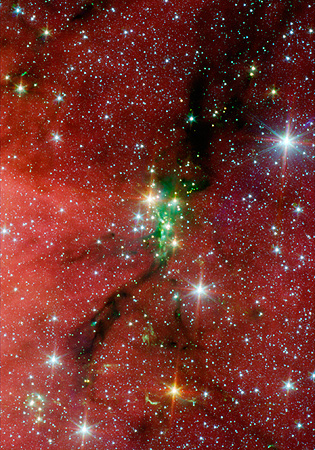16 August 2007

NASA/JPL-Caltech/L. Allen (Harvard-Smithsonian CfA) & Gould's Belt Legacy Team
NASA's Spitzer Space Telescope (SST), a space-based infrared observatory, recently imaged a cluster of young stars in the Serpens cloud, located approximately 848 light-years away from Earth. Scientists speculate that this discovery will yield new clues about the formation of star clusters, gravitationally-bound families of tens, or hundreds of stars.
"It is amazing how these stars really stand out in the Spitzer images. At visible wavelengths the stars cannot be seen at all—they are completely obscured by the dust in the cloud," said Dr. Robert Gutermuth, the Harvard-Smithsonian Center for Astrophysics (CfA). "This is the first time that anyone has ever seen these stars."
The astronomers dubbed this new cluster "Serpens South," as it is located in the southern portion of the Serpens cloud. This cluster consists of a relatively dense group of 50 young stars, 35 of which are very young and regarded as stellar infants. These stars, termed protostars, are just beginning to form. The Serpens cloud is visible among the stars of the constellation Serpens, the Snake.
The above picture is composed of three images taken with the telescope's Infrared Array Camera (IRAC) at wavelengths of 3.6, 4.5, and 5.8 microns. The three wavelengths are coded blue, green and red, respectively.
"Spitzer is currently the only telescope with the capabilities to find young star clusters like Serpens South, which are deeply embedded inside giant cosmic clouds of gas and dust," said Dr. Lori Allen, CfA.
Further Reading
SST
http://www.spitzer.caltech.edu/spitzer/index.shtml
A Unique Image of a Spectacular Galaxy
../home/NewsDetail.aspx?Find=%2fTXkgxsS3F3mZFSC%2bZincA%3d%3d
Aymen Mohamed Ibrahem
Senior Astronomy Specialist